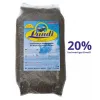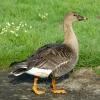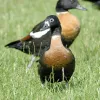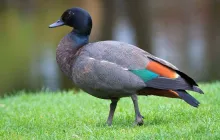
Paradise Shelduck (Tadorna variegata)
Naamgeving
- Nederlandse naam:
- Paradijscasarca
- Engelse naam:
- Paradise Shelduck - New Zealand Shelduck
- Duitse naam:
- Paradieskasarka
- Franse naam:
- Tadorne de paradis
- Wetenschappelijke naam:
- Tadorna variegata
Taxonomische indeling
- Orde:
- Anseriformes
- Familie:
- Anatidae
- Onderfamilie:
- Tadorninae
- Geslacht:
- Tadorna
Beschrijving
- Uiterlijke kenmerken:
Male:
Head and neck black, glossed green. Nearly all uderparts and upperparts sooty-black, breast, flanks and upper belly with fine grey vermiculations, mantle and scapulars finely vermiculated brown. Lower belly and undertail converts' rich chestnut; rump, uppertail-converts and tail black.Primary and secondary flight feathers are black, with green mirror on seconderies. On the underwing, the flight feathers are black, contrasting with the white coverts. Bill feet and legs dark Grey.Female:
Head and neck pure white. Almost all the body dark reddish chestnut, with fine blackish vermiculations on mantle. Lower belly and undertail converts rich chestnut; rump, uppertail-converts and tail black. Primary and secondary flight feathers are black, with green mirror on seconderies. On the underwing, the flight feathers are black, contrasting with the white coverts.Bill feet and legs dark Grey.Juvenile:
Much duller and Browner, including on head; lacks green speculum, and feathers of white forewing washed rufous -brown. Gain near adult plumage after first year.
Maten en Gewicht
- Lengte man:
- De man (woerd) van de Paradise Shelduck heeft een lichaamslengte van ongeveer 61-66 centimeters. De vrouw (pop) heeft een lichaamslengte van ongeveer 61-66 centimeters.
- Gewicht man:
- Het mannetje weegt ongeveer 1405-1680 gram. Het vrouwtje weegt ongeveer 1405-1680 gram.
Het gewicht is notoir variabel en kan alleen als indicatie worden gebruikt!
- Notitie:
All Shelducks are reasonably hardy, but shelter should be available in winter. Enclosure should contain grass for grazing; generally peaceable and may be kept in mixed collections with e.g. Anser spp. and large ducks; some individuals are seasonally aggressive and may require a separate enclosure. In general younger birds (less than three years old) may be less aggressive than older birds. In addition to grass, feeding with e.g. wheat and pellets suggested, also earthworms, insects and extra green food for breeding, with duckweed particularly for ducklings.
They tend to be aggressive particularly in the breeding season, and may even kill small ducks, and a separate enclosure is usually required. There is some species-based and individual variation in degree of aggression.
Most species prefer to use a partially-buried nest box with a tunnel entrance, usually in the form of a drain pipe. A suggested nest box size is 30x30x40cm, with a 15cm diameter entrance tunnel drain pipe, or 15x15cm square entrance tunnel, minimum 30cm long. Ground-level nest boxes with a 15cm diameter entrance hole may also be used.
Not always easy to breed. Ground-buried nest boxes, and buried or vegetation-hidden hollow logs and drainpipes should be provided for breeding, unless hollow trees or rabbit burrows are available. Laying may begin in February, usually lay March to May. Duckweed and rearing diet, plus small grains later, are useful for rearing ducklings. Artificial, broody and parent incubation and rearing may be used successfully. Care should be taken to avoid imprinting, which may lead to males aggressive to humans and females attracted to people.
Hybrids reported with Common shelduck (Tadorna tadorna), Ruddy shelduck (Tadorna ferruginea), South African shelduck (Tadorna cana), Ashy-headed goose (Chloephaga poliocephala), Bar-headed goose (Anser indicus) and domestic duck.
- Breeding:
- Het vrouwtje Paradise Shelduck legt doorgaans zo'n 7-10 creamy white eieren het broeden duurt 28-31 dagen.
- Kunstmatig broeden:
De ideale relatieve luchtvochtigheid voor het uitbroeden van de meeste watervogeleieren is 55% voor grondbroeders en 40% bij holenbroeders. De temperatuur is meestal 37,4° C. Stel ventilatie in zoals aanbevolen door de fabrikant van de broedmachine. Eieren moeten minimaal 4 keer per dag automatisch of met de hand worden gedraaid. Naarmate de vrucht zich ontwikkelt, verliest het ei water en wordt de luchtzak groter. Bij normale ontwikkeling van een ei met een incubatietijd van 28-31 dagen neemt de luchtzak ongeveer een derde van het ei in beslag, dit bij drie dagen voor uitkomst. Reinheid is van vitaal belang en idealiter moet de luchtvochtigheid worden verhoogd tot 65% nadat de eerste tekenen van uitkomst zichtbaar worden.
- Ringdagen:
- Aanbevolen passende ringmaat voor de Paradise Shelduck is 13 mm.De gesloten pootring kan alleen aangebracht worden bij een jonge shelduck van ongeveer 14 dagen oud.
- It doesn't matter what leg that you band, but it's good to have a consistent system. Suggested: Left leg = Female, Right leg = Male
- Opfokvoeder:
-



Floatable special rearing feed for all types of aquatic ornamental fowl - especially for the cultivation of trees as well as greening ducks.
This well-balanced complete feed with 20% protein content convinces above all by its good compatibility and forms the basis for visibly healthy growth from day one.
Made exclusively from wholesome and selected raw materials, Lundi Micro Regular is also ideally suited for the year-round feeding of waterfowl.
- Onderhoudsvoeder:
-





Floating full food for all sea ducks, green ducks, eider ducks and geese, especially in the moulting and breeding phase ideally suited. Packed with wholesome raw materials, natural vitamins and trace elements, this performance food with a protein content of 30% forms the basis for lifelong vitality.

